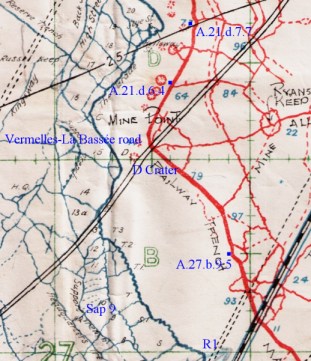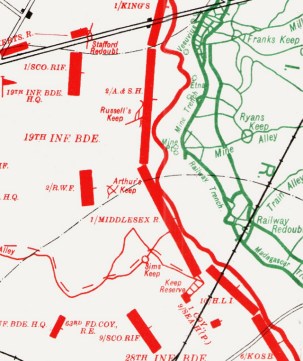 |
Homepage
Actions Maps More..... Mapping
notes
|
|
The Battle of Loos25th September-30th September 1915. When dawn broke on the morning of 25th it seemed as if the elements had again conspired to make the attack abortive, for heavy rain fell and the wind, what there was of it, shifted almost continually; it was a bad day for the projection of gas. Indeed, one Brigade of the 2nd Division (6th) notified Divisional Headquarters that the wind was unfavourable, but was ordered to proceed with the projection. So, at 5.50 a.m., the cylinders were opened and great clouds of asphyxiating gas were projected into the air, whilst the smoke candles were lighted. But instead of the gas floating across No Man's Land and settling down over the German trenches, it hung lifeless in the air or blew back upon the British trenches from which it had been projected, in many places with disastrous effects. The left Battalion (the Highlanders) of the 19th Brigade fared worse than the right-the Middlesex-for the ground in front of the former was much cut up by craters, and in these the gas hung about with exasperating stillness. Across No Man's Land the Germans could be seen donning gas masks and using sprays-in order to dispel the gas-whilst all along their parapets, at intervals of about 20-30 yards, they lighted fires for the same purpose, and by their activities they appeared quite unaffected by the noxious fumes. For forty minutes the gas projection lasted and then, at 6.30 a.m., the signal was given for the assault. "A", "B" and "C" Companies of the 1st Middlesex, awaiting the order to go forward, at once began their advance; "D" Company was in reserve. But the men had not gone more than a few yards ere a storm of rifle and machine-gun bullets tore their ranks to shreds and No Man's Land was soon littered with killed and wounded. Undeterred by the gas fumes the Germans stood up in their trenches, in many places upon the parapets, and poured a deadly accurate fire upon the advancing British troops. For not alone from in front of the gallant Die-Hards did fierce resistance take place, but all up and down the line. Unable to make further progress, the Middlesex men laid down. By this time the German trenches, which when the advance began had been lightly held, were packed with men and the volume of fire increased. With orders to reinforce the three forward companies, "D" Company now "went over the top," only to share a similar fate, and survivors lay close to the ground with a rain of bullets pouring overhead. The Battalion Diary records the action in the following and all too brief words: "At 5.50 a.m. a gas attack was opened on the German trenches for 40 minutes. This was not, however, very successful, and did not have much effect. At 6.30 the Battalion attacked with three Companies in the front line and one Company ("D") in reserve. The Battalion was all flung into the line, but failed to get further forward than 100 yards and were then hung up. Gunners again shelled the hostile line, but no further advance was made. At 12 noon the Battalion was ordered to withdraw into Brigade Reserve, having lost very heavily in both officers and men. A large proportion of N.C.Os. were casualties." Trench co-ordinates. How to read a trench map
The 19th Brigade Diary throws but little further light on the action, though the position of the Brigade at 7.30 a.m. is given thus: "1st Middlesex about 100 yards in front of our front-line trenches; 2nd A. and S. Highlanders being under cover of the German parapet by the wire " (a terrible position). Then a little later the narrative states: "2nd A. and S. Highlanders withdrawn to their original trenches, leaving many men behind, including two complete platoons who reached the German front trenches. 1st Middlesex, trying to get on, are a hundred yards in front. Artillery shell the German front line very heavily. A bombardment under 2nd Divisional orders was arranged to start at 9a.m., after which infantry were to advance. 2nd Royal Welch Fusiliers now put out two companies to support the Middlesex, but they were met with fierce opposition and lose heavily. Bombers of 1st Middlesex reach the craters at "D," but are heavily fired on by our own artillery." At 9.45a.m. orders were received at Brigade Headquarters stating that as the attack on the right of the 2nd Division was progressing favourably, no further attack was to be made for the present by the 19th Brigade and the 6th Brigade ( the latter was on the left of the former). Amongst the appendices to the Diary of the 19th Infantry Brigade, however, are several field messages of special interest to the Middlesex Regiment, and although there are gaps in the story it is possible to follow the course of the Battle from a battalion point of view. The first message, timed 6.57 a.m., is from Brigade Headquarters to Battalion Headquarters Middlesex and reads: "Any news aaa How far have you advanced aaa Is gas returning you aaa Keep me well informed so that artillery barrage may be altered to suit if you want it." In reply to this message there follow several, one after the other, from the O.C. Middlesex, and they are given in their correct order, though the first was evidently despatched while the Brigade message was on its way to Battalion Headquarters: (i) "6.50 a.m. Much opposition to our front. Please ask guns to shell Les Briques trench." (ii) "7 a.m. Reserve company has got on, but we are being very heavily fired at." (iii) "7.16 a.m. Line held up. Very heavy fire aaa Have " (here the message is overwritten and is unreadable. (iv) "7.20 a.m. Ask guns to shell German front-line trench aaa Railway trench I mean." (v) "7.26 a.m. Don't think gas is affecting us or Germans. They are holding their front-line trench aaa Our Battalion is all out in area between their front trench and ours aaa 2nd Royal Welch Fusiliers are now up aaa It is essential to now shell hostile front trench." (vi) "7.30 a.m. Reported casualties probably 400, but impossible to tell aaa Have observed an enormous number fall." ( vii) "7.55 a.m. Must shell German first line aaa Our men are all out in front aaa Almost all must be killed or wounded aaa Please shell first line aaa Welch Fusiliers are now advancing." And, at 8 a.m. the Commanding Officer asks for men for the attack on his left: "Is there any news re Argylls and Sutherlands ?" It is apparent from the last message that no news had reached the Commanding Officer of the Middlesex from his own front line of the situation on his left flank. About 8 a.m., however, Colonel Rowley received the following message from Lieut. A. D. Hill ( commanding "C" Company): "Enemy very strong in front with machine-guns and rifles. "C" Company strength only about 30 or 35 men. Impossible to advance on account of machine guns. Mr. Henry and 3 men alone remain out of two platoons. Can we have reinforcements ? We are in Square 27B in crater S.E. of road and about 60 yards south Point 79." To which, at 8.12 a.m., Colonel Rowley replied: "Hang on where you are until reinforced." The next message is written on a small muddy and blood-stained piece of paper: "8.30 a.m. "B" Company attack held up 100 yards out of own trench. Major Swainson wounded. "B" Company knocked out, few men stand fast." It is signed "P. Choate, 2nd Lieutenant." The only other information received by Colonel Rowley from No Man's Land was a second message from Lieut. Choate, timed 10.50 a.m.: "So far as can ascertain "B" Company nearly wiped out. A few men are lying near me 100 yards in front of our front trench to left of wrecked aeroplane and facing Les Briques Farm. I have not enough men to advance further. Can you reinforce or give orders ?" There is no reply in the Diaries to this message. The one bright spot in the attack was an assault from the left flank carried out by the Grenade Reserve platoon, assisted by a platoon of the Reserve Company ("D"). These gallant fellows attacked a large crater (at D) and actually captured it. There is little more to tell ! At 1.15 p.m. the Battalion- all that was left of it-was ordered into reserve at Siding No. 3 and Braddell Trench. When this movement had been carried out, but a handful of men-84 other ranks-were mustered, though when darkness had fallen over the battlefield on the night of 25th other men, who had been lying out all day in No 2 Man's Land, were able to withdraw. The little party of "D" Company who had hung on to the crater they had captured were also withdrawn. During the day they had actually pushed beyond the crater, but were held up by very thick hostile wire entanglements, and the grenade officer was killed whilst trying to force a way through. A machine gun had also been pushed forward into the crater and did great execution, but the machinegun officer being wounded, the gun had to be withdrawn. Throughout the morning the Battalion stretcher-bearers performed many gallant deeds and worked heroically Ten officers killed (Captains N. Y. L. Welman, F. V. A. Dyer, L. G. Coward and R. J. Deighton; 2nd Lieuts. C. A. J. Mackinnon, C. Pery, B. U. Hare, A. L. Hill, R. C. Mellish, J. H. Linsell; Lieut. A. W. R. Carless died of wounds on 27th September.) and 7 wounded; 73 other ranks killed, 285 wounded, 66 missing, 7 gassed and 2 suffering from shell concussion-a total of 455-were the casualties suffered by the 1st Middlesex throughout the day. Well indeed might the Brigadier-General (P. R. Robertson) commanding 28th Brigade write in a letter to Colonel Rowley, dated 26th September: "Please convey to all ranks my very high appreciation of the splendid behaviour of all ranks in yesterday's action. They did all that it was possible to do under such circumstances; their conduct was most gallant and fully upheld the fine reputation of the Die-Hards." Report by F. Rowley, Lieut. Colonel Commanding 1st Middlesex Regiment.
26th-30th September From the 26th to the 30th September the 1st Battalion remained in Brigade Reserve in dug-outs behind the front line, and here for a while it is necessary to leave them and relate what befell the other Battalions of the Regiment on the first day of the Battle. From the official despatches it is clear that whereas the southern portion of the initial attack from Loos, northwards to the neighbourhood of Fosse 8, had gained ground, north of the latter point to the La Bassée Canal and just beyond it from the Givenchy front, no progress had been made. This was the position about 9.30 a.m., when Sir John French placed the 21st and 24th Divisions at the disposal of the G.O.C. First Army, who ordered them up in support of the attacking troops. Between 1a.m. and 12 noon the central brigades of these Divisions filed past Sir John at Béthune and Noeux-les-Mines respectively. At 11.30 a.m. the heads of both divisions were within three miles of the original British front line. The main operations of the Battle of Loos ended on 8th October, but meanwhile subsidiary attacks had been made by the Vth Corps on the Bellewaarde Ridge, east of Ypres, and by the 3rd and Indian Corps north of the La Bassée Canal and along the whole front of the Second Army. Go to Trench Warfare leading to the Somme 1916 or Back to list of actions |
||||||||||||||
|

